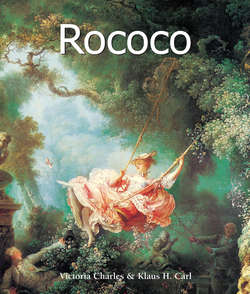Читать книгу Rococo - Victoria Charles - Страница 8
На сайте Литреса книга снята с продажи.
I. Rococo in France
Fashion
ОглавлениеAt the start of the 18th century, the corset was reintroduced into the fashion realm. Since undergarments come into direct contact with the skin, they have always been an object of male fantasy. The corset on the body assumed the same function as scaffolding on a building. The function of the corset was to give effect to the bodily forms in accordance with the fashion. The corset restricted the body in compliance with fashion, and in doing so often had no regard for the natural shape of its wearer. The breasts were rounded, lifted, beautifully shaped or pressed flat; the hips became narrower or spread wider.
The corset was sometimes coordinated with the wardrobe or with other underwear such as the petticoat, and it was dependent on fashion and thus the object of vitriolic criticism. Its champions regarded it as the symbol of feminine morality, whereby the constriction of the body was equated with austerity of character. Its opponents, the doctors, hygienists and later the feminists, accused the manufacturers and creators of fashion of squeezing women’s bodies into an unnatural scaffolding which brought with it physical damage.
Antoine Watteau, Party in the Open Air, 1718–1720.
Oil on canvas, 111 × 163 cm.
Staatliche Museen zu Berlin, Gemäldegalerie, Berlin.
Jean-Honoré Fragonard, Blind-Man’s Bluff, c. 1750–1752.
Oil on canvas, 114 × 90 cm.
Toledo Museum of Art, Toledo (Ohio).
Carle van Loo (Charles André van Loo), The Spanish Reading, 1754.
Oil on canvas, 164 × 129 cm.
The State Hermitage Museum, St. Petersburg.
After the iron corset in the first half of the 17th century, the garment became rather looser and was usually made out of satin or silk on a framework of wire or whalebone, stretching way below the body. This kind of corset was worn even by young girls in the 18th century. At this time the farthingale, a framework of hoops worn under the skirt, gave way to the puffy dress and the crinoline, also called the pannier (basket) or tournure (bustle), giving the skirt its shape, but of course the shapes were subject to prevailing fashion. Around 1720, this shape tended to be round, but ten years later it was oval and subsequently even conical. In the middle of the 18th century the front and back of the skirt were given a very flat shape by two small panniers fitted on the sides, but the skirt was also laterally far outstretched. At the end of this century, the pannier was replaced by the bustle, which emphasised or embellished the natural shape of the rear. Above this the manteau (coat), worn open at the front, was predominant.
The gentlemen, not only in France, wore under the three-cornered hat, also known as the three-master or fog-splitter, a bag-wig, which gradually displaced the curly, voluminous, full-bottomed wig and consisted of a black silk bag containing the neck hairs or the end of the wig. The Prince of Brandenburg, Frederick William I (1657–1713), introduced into Prussia the tie-wig, which was especially popular amongst members of the military. At court and in the aristocratic circles that frequented it, the just-au-corps, a collarless, jerkin-styled coat buttoned at the front and reaching over the breeches to the knees, was worn over the jacket. It was not until the middle of the 18th century that the English fitted a collar to this garment, which was then taken over by the French as a stand-up collar. So that the coat did not obstruct the dagger carried by every gentleman, the back seam, from around the hips and downwards, was left open.
At the beginning of the 18th century it was still France that, in questions of elegance, set the tone throughout Europe. Ladies’ shoes were made of silk and bore large buckles on the insteps. The form of the shoes changed only slightly in the period between the Regency and the French Revolution. The toe cap was round or pointed and sometimes raised. Two kinds of shoes were popular: the slipper was worn indoors and the high-heeled shoe was worn to go with elegant clothes. The slipper with a heel of varying height was covered with satin, silk or white leather and often embroidered. Engravings from this period show numerous models with both types of shoes. The picture The Swing (1767) by Jean-Honoré de Fragonard (1732–1806), shows a young woman sitting on a swing with a playfully-raised skirt, who sends a dainty pink slipper flying towards her admirer crouching in the bushes. The chased silver buckles, set with paste or genuine precious stones, were kept in jewellery caskets and handed down to later generations. When one went out, the shoes were protected by wooden slippers or clogs fastened on the top of the foot with two leather straps.
The men’s shoes were adorned with buckles and had a simple form with flat heels. Made of dark or black leather, they were shown off to their best advantage with silk trousers and brightly-coloured stockings made of satin or silk. Boots were a fashion later imported from England.
These clothes were taken over by the bourgeoisie, which in the course of the century became increasingly more established.
Antoine Watteau, An Embarrassing Proposal, 1715–1716.
Oil on canvas, 65 × 84.5 cm.
The State Hermitage Museum, St. Petersburg.
François Boucher, Morning Coffee, 1739.
Oil on canvas, 81 × 65 cm.
Musée du Louvre, Paris.
Germain Boffrand and Charles Joseph Natoire, Hôtel de Soubise, Chambre de parade de la princesse, 1735–1739. Paris.
Pierre Alexis Delamair, Hôtel de Soubise, front, courtyard side, 1704–1707. Paris.
